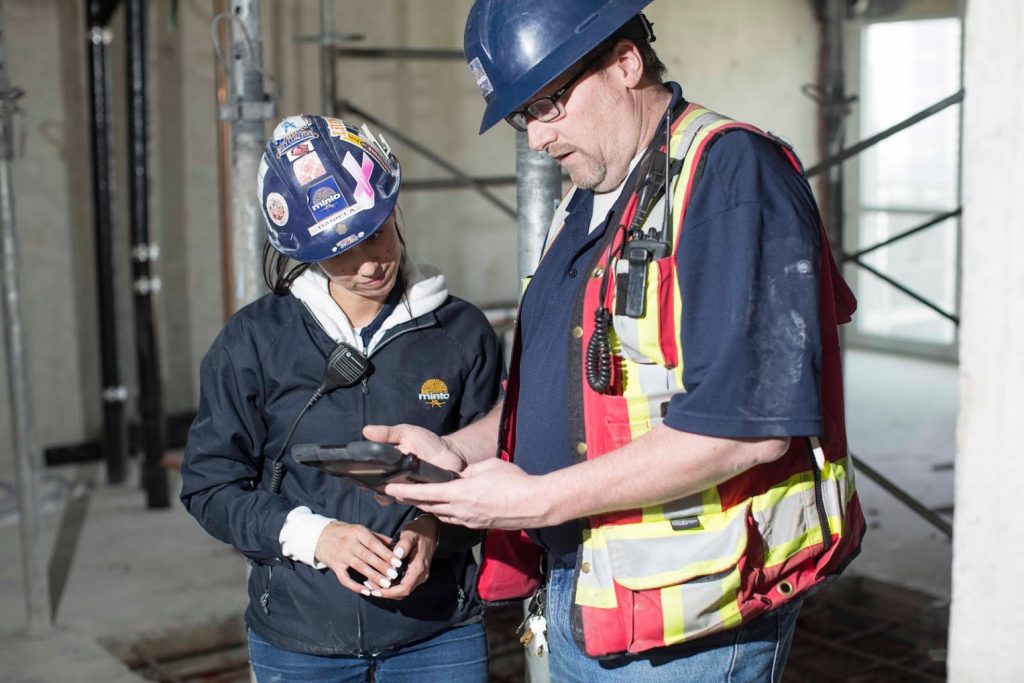
Products & Equipment
In-Depth
Ontario researchers hunt cranes to help hone their software apps
December 23, 2015 By Saul Chernos
 Software platform enables general contractors to communicate with and manage subcontractors
Software platform enables general contractors to communicate with and manage subcontractorsWant to find local construction sites? Two University of Western Ontario students looking to develop software technology for the construction sector used tower cranes as beacons to guide their market research.
Lauren Hasegawa and Mallorie Brodie were in their final year of civil engineering and business
studies, respectively, when they teamed up through a business accelerator program to launch a software-based platform to help general contractors communicate with and manage subcontractors.
“My grandfather was in construction and I’d worked in construction as a junior engineer,” Hasegawa explains. “I’d noticed it was a very pen-and-paper-based industry. There wasn’t a lot of technology on the sites I’d been on.”
Brodie also had family members in construction and, together, the two of them realized something was needed. Exactly what, however, was the question.
“We realized we didn’t know enough and needed feedback,” Hasegawa says. “So we started going to construction sites to talk with people and see what we could learn.”
London, Ont., where UWO is located, was experiencing a construction boom, so there were plenty of sites to visit. The problem, Hasegawa says, was they didn’t know of any comprehensive list of active construction projects.
That’s when they decided to hunt cranes.
“Cranes have such a presence,” Hasegawa says. “They signalled to us right away that if there’s a crane then there’s got to be a construction site.”
Scouting around in boots and hardhats
The duo spent four months scouting around. “We’d see one in the distance and drive in that direction,” Hasegawa says. “Once we got closer we could tell what type of project it was, whether it was late-stage or early-stage, and we’d tailor our questions accordingly.”
Showing up with work boots and hard hats, Hasegawa and Brodie headed for the construction office and anywhere else they felt welcome, and talked to anyone and everyone who was willing to spare a few minutes. After explaining the purpose of their visit, they invited workers and managers alike to share their everyday challenges and frustrations.
“They wanted us to help them, so they started inviting us back and we ended up job shadowing on sites, showing up to meetings and getting immersed in everything that was going on,” Hasegawa says. “It gave us this whole perspective as to what was actually happening.”
Hasegawa and Brodie analyzed their findings, identified trends and over-arching concerns, and came out with their company Bridgit’s first product. Closeout, a software-based platform, works on smartphones and computers of all sizes with a view to helping general contractors streamline communications with sub-trades and other stakeholders such as architects, engineers, developers and project owners.
“Typically, communication has been done by hand,” Hasegawa says, explaining that plans and drawings are changed frequently and communications challenges often arise when multiple parties rely on telephone calls, e-mail, printed spreadsheets and bulletin boards.
“Projects were being managed with Post-it notes and handwritten charts where they would track literally hundreds of moving parts,” Hasegawa says. “We heard about workers not being able to track what finishes were done in individual rooms, or whether a particular colour of paint or hardwood was needed in one room versus another.”
Software access extends to all participants
Closeout is designed to streamline the entire process electronically. While the general contractor pays for the platform, access is ultimately extended to all project participants who are provided with individualized access to portals with information only they need to know.
Users can log in, read memos, instructions or other pertinent information, and respond to any party that might be affected, and everything can be viewed and tracked by the general contractor.
The platform even encourages photos. All parties to a project can upload images to point out problems or establish that work has been completed.
“It takes all the hassle of the communications side and puts it into an app and a website where everyone can collaborate,” Hasegawa says.
While general contractors need a password to view the entire system, subcontractors simply follow web links sent to them, usually on a daily basis.
“The subs don’t need to download anything or have a smartphone or sign up or have a password,” Hasegawa says. “We learned from doing our research how many subcontractors there were on these projects and how crazy-difficult or pretty much impossible it would be if they had to use passwords for different projects. So they’re integrated into the system purely from their e-mail address.”
While Closeout works from any current laptop or desktop computer, smartphones and other mobile devices are presently Apple-only. This means iPhones and iPads are in, but not Blackberries, Androids or PC tablets.
Thus far the application isn’t widely used by crane operators. Hasegawa says the platform, in its early years and is geared mainly to interior work such as plumbing, painting and electrical. That may change as the platform evolves, she adds.
Hasegawa estimates 1,000 individuals are logging in but declined to state the number of projects. With six employees, Bridgit has markets mainly Canadian, with some American users. However, the company, based in Kitchener, plans to continue to grow both markets.
— Saul Chernos
Print this page